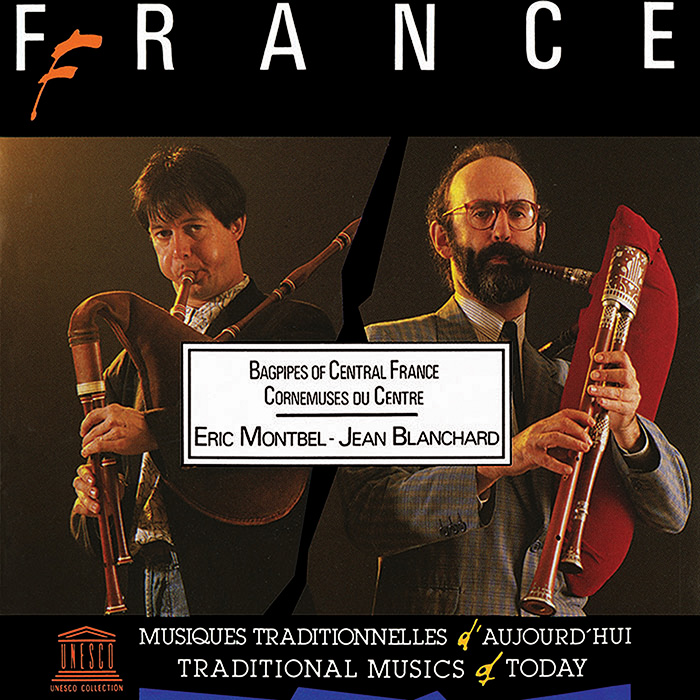-
UNESCO Collection Week 18: Bagpipes of Bulgaria and France
As the International Bagpipe Festival (Mezinárodní dudácký festival) in the Czech Republic wraps up, we turn our attention this week to two albums—France: Bagpipes of Central France and Bulgaria—featuring bagpipe music.
GUEST BLOG
by Kevin Levine
The albums selected for release this week present an unlikely pairing. Admittedly, when I initially chose to compare an album of Bulgarian music to one of Central-French bagpiping, no particular point of intersection stood out to me except for a few loose commonalities pertaining to musical function and subsistence patterns. For instance, both musics support dances and have been influenced by pastoral lifestyles. After listening to each album multiple times, however, it occurred to me that my attention was continually brought back to the prevalence of drones in the textures of both recordings.
The most easily identifiable types of drones heard on the selected albums are those produced by the Bulgarian and French bagpipes. In France: Bagpipes of Central France, either two or three drones are featured on each track depending on the type of bagpipe being performed. For example, Jean Blanchard’s musette de cour, a small French bagpipe heard in “Sur le pont d’auron” (track 6), and Eric Montbel’s Central-French bagpipe chabrette in “N’aven tan dansa” (track 5) both generate two drone notes while Blanchard’s musette Bechonnet in “Le retour du jardinière” (track 3) yields three constant drone pitches. In contrast, the gajda, a goatskin bagpipe commonly found in southeastern Europe (Bulgaria: tracks 3 and 14), has only one drone reed, thereby producing a single, uninterrupted pitch.AudioApart from the fixed drones of the bagpipes, one encounters two types of non-fixed droning effects on the album of Bulgarian music. The first is created by a diaphonic vocal technique wherein two or more voices in a choir alternate between two pitches (often the tonic and subtonic tones), which are sustained briefly in order to produce a moving drone. This is a characteristic feature of women’s group singing from the Shope region of west-central Bulgaria and can be heard on “Harvest song” (tracks 5 and 9) and “Lazarus Day song” (tracks 6 and 7). The other non-fixed droning effect appears on track 11 of the Bulgarian album in which two zurna (shawm-like double reed instrument) players perform a set of pieces in a style associated with the Pirin region of southwest Bulgaria. On this track, one musician performs the primary melodic role while the other alternates between playing the melody and sustaining single tones. Musicians performing in this manner can create dramatic variations in a piece simply by changing the moments when they alternate between performing in unison and as a melody/drone pair.AudioWhile it might seem as though these various drones and droning techniques serve a relatively simple musical function, in reality, they constitute a substantial part of their respective genres in three primary manners. First, in the case of bagpipe performance, drones contribute to a harmonically rich timbre with a distinctive “buzzing” quality. The dense harmonics of both the French and Bulgarian bagpipes lends these instruments a sonic quality that is as much felt as it is heard.
Second, the relationship between drone and melody voices in a performance frequently yields dissonant intervals. To those more attuned to the conventions of Western classical harmony, these dissonances can seem quite surreal. In fact, it is for this very reason that American television and film score composer Joseph LoDuca employed a Bulgarian women’s choir to record the theme song for the popular 1990s television show, Xena: Warrior Princess. To performers of both Bulgarian and French traditional music, however, the dissonances created by fixed or non-fixed drones are considered pleasant rather than jarring. Musicians from the Shope region of Bulgaria, in particular, accentuate dissonances by elongating certain phrases or shifting the melody/drone relationship.
Finally, non-fixed droning techniques allow musicians to emphasize or even change the mood of a piece without directly altering the melody. While the same effect can be observed in any circumstance in which voices are arranged, droning produces a uniquely uninterrupted, gliding harmony that deserves special attention.
Kevin Levine
M.A. Ethnomusicology, UCLAUNESCO Collection Week 18: Bagpipes of Bulgaria and France | Smithsonian Folkways Recordings



